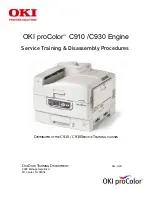
Chapter 10 Machine Overview
10.1 Print Process
10-5
[Developing]
This step draws toner on an invisible latent electrostatic image on the drum surface and forms a
visible toner image on the drum.
- This device uses dry-type one-component magnetic toner. Toner is supplied from the toner room
to the magnet roll adjacent to the drum surface in the Drum/toner cartridge by the agitator. Toner
is drawn to the magnet roll surface with a little magnetism and formed to a too thin even layer on
the magnet roll by the CM blade (Charging & Metering blade).
The CM blade is equipped with a rubber coming into contact with toner. Toner is charged with
minus power by friction with the rubber.
The magnet roll is covered by a thin electric-conductive sleeve. The DB (Developing Bias) voltage
is supplied from the HVPS to the electric-conductive sleeve. The DB voltage is generated by
superposing AC voltage on minus DC voltage. The DC voltage holds the magnet roll at the fixed
minus potential for the conductive layer of the drum. On parts on which minus charge does not
reduce on the drum surface, the potential is lower than the magnet roll; on parts on which minus
charge reduces on the drum surface, the potential is higher than the magnet roll. The AC voltage
is used to shake toner on the magnet roll so that toner scatters smoothly.
The toner charged with minus power is therefore drawn only to the parts (latent electrostatic
image) with lower minus charge on the drum surface from the magnet roll, forming a toner image
on the drum. (Since the attractive force of the positive charge in the conductor layer of the drum is
greater than the resiliency of the minus charge on the drum surface, toner is drawn even while
being repulsed by minus charge.)
When toner sticks on the surface, minus charge at the stick part increases and the potential
reduces, and the force drawing toner lowers.
Summary of Contents for DocuPrint 2050
Page 1: ...DocuPrint 2050 Service Manual 1st Edition KON001CA ...
Page 3: ...Company Name Department Name Telephone No Full Name Employee No ...
Page 5: ...Preface ...
Page 11: ...Chapter 1 Service Call Procedure ...
Page 19: ...Chapter 2 Troubleshooting ...
Page 85: ...Chapter 3 Image Quality Troubleshooting ...
Page 114: ...Chapter 4 Disassembly Assembly and Adjustment ...
Page 193: ...Chapter 5 Parts List ...
Page 207: ...Chapter 6 General ...
Page 243: ...Chapter 7 Wiring Data ...
Page 247: ...Chapter 7 Wiring Data 7 1 Connector P plug J jack 7 4 ...
Page 252: ...Chapter 7 Wiring Data 7 3 Wiring Diagram between Parts 7 9 Continued from the preceding page ...
Page 264: ...Chapter 10 Machine Overview ...
















































